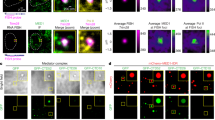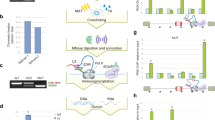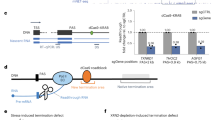Abstract
Mounting evidence suggests that transcription and RNA processing are intimately coupled in vivo, although each process can occur independently in vitro. It is generally thought that polymerase II (Pol II) C-terminal domain (CTD) kinases are recruited near the transcription start site to overcome initial Pol II pausing events, and that stably bound kinases facilitate productive elongation and co-transcriptional RNA processing. Whereas most studies have focused on how RNA processing machineries take advantage of the transcriptional apparatus to efficiently modify nascent RNA, here we report that a well-studied splicing factor, SC35, affects transcriptional elongation in a gene-specific manner. SC35 depletion induces Pol II accumulation within the gene body and attenuated elongation, which are correlated with defective P-TEFb (a complex composed of CycT1–CDK9) recruitment and dramatically reduced CTD Ser2 phosphorylation. Recombinant SC35 is sufficient to rescue this defect in nuclear run-on experiments. These findings suggest a reciprocal functional relationship between the transcription and splicing machineries during gene expression.
This is a preview of subscription content, access via your institution
Access options
Subscribe to this journal
Receive 12 print issues and online access
$189.00 per year
only $15.75 per issue
Buy this article
- Purchase on Springer Link
- Instant access to full article PDF
Prices may be subject to local taxes which are calculated during checkout






Similar content being viewed by others
References
Maniatis, T. & Reed, R. An extensive network of coupling among gene expression machines. Nature 416, 499–506 (2002).
Pandit, S., Wang, D. & Fu, X.-D. Functional integration of transcriptional and RNA processing machineries. Curr. Opin. Cell Biol. 20, 260–265 (2008).
Lacadie, S.A., Tardiff, D.F., Kadener, S. & Rosbash, M. In vivo commitment to yeast cotranscriptional splicing is sensitive to transcription elongation mutants. Genes Dev. 20, 2055–2066 (2006).
Lacadie, S.A. & Rosbash, M. Cotranscriptional spliceosome assembly dynamics and the role of U1 snRNA:5′ss base pairing in yeast. Mol. Cell 19, 65–75 (2005).
Gornemann, J., Kotovic, K.M., Hujer, K. & Neugebauer, K.M. Cotranscriptional spliceosome assembly occurs in a stepwise fashion and requires the cap binding complex. Mol. Cell 19, 53–63 (2005).
Listerman, I., Sapra, A.K. & Neugebauer, K.M. Cotranscriptional coupling of splicing factor recruitment and precursor messenger RNA splicing in mammalian cells. Nat. Struct. Mol. Biol. 13, 815–822 (2006).
Bres, V., Gomes, N., Pickle, L. & Jones, K.A. A human splicing factor, SKIP, associates with P-TEFb and enhances transcription elongation by HIV-1 Tat. Genes Dev. 19, 1211–1226 (2005).
Das, R. et al. Functional coupling of RNAP II transcription to spliceosome assembly. Genes Dev. 20, 1100–1109 (2006).
de la Mata, M. et al. A slow RNA polymerase II affects alternative splicing in vivo. Mol. Cell 12, 525–532 (2003).
Howe, K.J., Kane, C.M. & Ares, M. Jr. Perturbation of transcription elongation influences the fidelity of internal exon inclusion in Saccharomyces cerevisiae. RNA 9, 993–1006 (2003).
Bentley, D.L. Rules of engagement: co-transcriptional recruitment of pre-mRNA processing factors. Curr. Opin. Cell Biol. 17, 251–256 (2005).
Fong, N., Bird, G., Vigneron, M. & Bentley, D.L. A 10 residue motif at the C-terminus of the RNA pol II CTD is required for transcription, splicing and 3′ end processing. EMBO J. 22, 4274–4282 (2003).
Reed, R. Coupling transcription, splicing and mRNA export. Curr. Opin. Cell Biol. 15, 326–331 (2003).
Proudfoot, N.J., Furger, A. & Dye, M.J. Integrating mRNA processing with transcription. Cell 108, 501–512 (2002).
Saunders, A., Core, L.J. & Lis, J.T. Breaking barriers to transcription elongation. Nat. Rev. Mol. Cell Biol. 7, 557–567 (2006).
Ni, Z., Schwartz, B.E., Werner, J., Suarez, J.R. & Lis, J.T. Coordination of transcription, RNA processing, and surveillance by P-TEFb kinase on heat shock genes. Mol. Cell 13, 55–65 (2004).
Sims, R.J. III, Belotserkovskaya, R. & Reinberg, D. Elongation by RNA polymerase II: the short and long of it. Genes Dev. 18, 2437–2468 (2004).
Lis, J.T., Mason, P., Peng, J., Price, D.H. & Werner, J. P-TEFb kinase recruitment and function at heat shock loci. Genes Dev. 14, 792–803 (2000).
O'Brien, T., Hardin, S., Greenleaf, A. & Lis, J.T. Phosphorylation of RNA polymerase II C-terminal domain and transcriptional elongation. Nature 370, 75–77 (1994).
Phatnani, H.P. & Greenleaf, A.L. Phosphorylation and functions of the RNA polymerase II CTD. Genes Dev. 20, 2922–2936 (2006).
Komarnitsky, P., Cho, E.J. & Buratowski, S. Different phosphorylated forms of RNA polymerase II and associated mRNA processing factors during transcription. Genes Dev. 14, 2452–2460 (2000).
Fong, Y.W. & Zhou, Q. Stimulatory effect of splicing factors on transcriptional elongation. Nature 414, 929–933 (2001).
Yan, D. et al. CUS2, a yeast homolog of human Tat-SF1, rescues function of misfolded U2 through an unusual RNA recognition motif. Mol. Cell. Biol. 18, 5000–5009 (1998).
Albers, M., Diment, A., Muraru, M., Russell, C.S. & Beggs, J.D. Identification and characterization of Prp45p and Prp46p, essential pre-mRNA splicing factors. RNA 9, 138–150 (2003).
Zhou, Z., Licklider, L.J., Gygi, S.P. & Reed, R. Comprehensive proteomic analysis of the human spliceosome. Nature 419, 182–185 (2002).
Kim, H.J. et al. mRNA capping enzyme activity is coupled to an early transcription elongation. Mol. Cell. Biol. 24, 6184–6193 (2004).
Schroeder, S.C., Zorio, D.A., Schwer, B., Shuman, S. & Bentley, D. A function of yeast mRNA cap methyltransferase, Abd1, in transcription by RNA polymerase II. Mol. Cell 13, 377–387 (2004).
Mandal, S.S. et al. Functional interactions of RNA-capping enzyme with factors that positively and negatively regulate promoter escape by RNA polymerase II. Proc. Natl. Acad. Sci. USA 101, 7572–7577 (2004).
Lin, S. & Fu, X.-D. SR Proteins and related factors in alternative splicing. in Alternative Splicing in the Postgenomic Era. vol. 623 107–122 (eds. Blencowe, B. & Graveley, G.) (Eurekah Bioscience, New York, NY, 2007).
Fu, X.D. Specific commitment of different pre-mRNAs to splicing by single SR proteins. Nature 365, 82–85 (1993).
Wang, J., Takagaki, Y. & Manley, J.L. Targeted disruption of an essential vertebrate gene: ASF/SF2 is required for cell viability. Genes Dev. 10, 2588–2599 (1996).
Lin, S., Xiao, R., Sun, P., Xu, X. & Fu, X.D. Dephosphorylation-dependent sorting of SR splicing factors during mRNP maturation. Mol. Cell 20, 413–425 (2005).
Xiao, R. et al. Splicing regulator SC35 is essential for genomic stability and cell proliferation during mammalian organogenesis. Mol. Cell. Biol. 27, 5393–5402 (2007).
Ding, J.H. et al. Dilated cardiomyopathy caused by tissue-specific ablation of SC35 in the heart. EMBO J. 23, 885–896 (2004).
Lemaire, R. et al. Stability of a PKCI-1-related mRNA is controlled by the splicing factor ASF/SF2: a novel function for SR proteins. Genes Dev. 16, 594–607 (2002).
Wang, J., Xiao, S.H. & Manley, J.L. Genetic analysis of the SR protein ASF/SF2: interchangeability of RS domains and negative control of splicing. Genes Dev. 12, 2222–2233 (1998).
Blanchette, M., Green, R.E., Brenner, S.E. & Rio, D.C. Global analysis of positive and negative pre-mRNA splicing regulators in Drosophila. Genes Dev. 19, 1306–1314 (2005).
Fu, X.D. & Maniatis, T. Factor required for mammalian spliceosome assembly is localized to discrete regions in the nucleus. Nature 343, 437–441 (1990).
Kwon, Y.S. et al. Sensitive ChIP-DSL technology reveals an extensive estrogen receptor α-binding program on human gene promoters. Proc. Natl. Acad. Sci. USA 104, 4852–4857 (2007).
Strahl, B.D. & Allis, C.D. The language of covalent histone modifications. Nature 403, 41–45 (2000).
Turner, B.M. Histone acetylation and an epigenetic code. Bioessays 22, 836–845 (2000).
Sims, R.J. III, Nishioka, K. & Reinberg, D. Histone lysine methylation: a signature for chromatin function. Trends Genet. 19, 629–639 (2003).
Greenberg, M.E. & Bender, T.P. Identification of newly transcribed RNA. Curr. Protoc. Mol. Biol. 4, 10.1–10.7 (2007).
Pellizzoni, L., Charroux, B., Rappsilber, J., Mann, M. & Dreyfuss, G. A functional interaction between the survival motor neuron complex and RNA polymerase II. J. Cell Biol. 152, 75–85 (2001).
Misteli, T. & Spector, D.L. RNA polymerase II targets pre-mRNA splicing factors to transcription sites in vivo. Mol. Cell 3, 697–705 (1999).
Das, R. et al. SR proteins function in coupling RNAP II transcription to pre-mRNA splicing. Mol. Cell 26, 867–881 (2007).
Fujinaga, K. et al. Dynamics of human immunodeficiency virus transcription: P-TEFb phosphorylates RD and dissociates negative effectors from the transactivation response element. Mol. Cell. Biol. 24, 787–795 (2004).
Yamada, T. et al. P-TEFb-mediated phosphorylation of hSpt5 C-terminal repeats is critical for processive transcription elongation. Mol. Cell 21, 227–237 (2006).
Cho, E.J., Kobor, M.S., Kim, M., Greenblatt, J. & Buratowski, S. Opposing effects of Ctk1 kinase and Fcp1 phosphatase at Ser 2 of the RNA polymerase II C-terminal domain. Genes Dev. 15, 3319–3329 (2001).
Champlin, D.T., Frasch, M., Saumweber, H. & Lis, J.T. Characterization of a Drosophila protein associated with boundaries of transcriptionally active chromatin. Genes Dev. 5, 1611–1621 (1991).
Champlin, D.T. & Lis, J.T. Distribution of B52 within a chromosomal locus depends on the level of transcription. Mol. Biol. Cell 5, 71–79 (1994).
Huang, Y. & Steitz, J.A. Splicing factors SRp20 and 9G8 promote the nucleocytoplasmic export of mRNA. Mol. Cell 7, 899–905 (2001).
Weber, M.J. & Rubin, H. Uridine transport and RNA synthesis in growing and in density-inhibited animal cells. J. Cell. Physiol. 77, 157–168 (1971).
Acknowledgements
We are grateful to Q. Zhou (Univeristy of California, Berkeley) and K. Jones (The Salk Institute) for advice, reporter plasmids and antibodies, K. Hertel (University of California, Irvine) for recombinant 9G8 and J. Hagopian (University of California, San Diego) for recombinant SF2/ASF. We thank M. Ares (University of California, Santa Cruz), B. Hamilton (University of California, San Diego), C. Glass (University of California, San Diego) and M.G. Rosenfeld (University of California, San Diego) for critical reading of the manuscript. This work was supported by a US National Institutes of Health (NIH) postdoctoral fellowship to G.C.-M. (1F32 GM077907) and NIH grants to X.-D.F. (5RO1 GM49369).
Author information
Authors and Affiliations
Contributions
X.-D.F. and S.L. designed the experiment; S.L. developed the modified nuclear run-on assay and performed most initial experiments; G.C.-M. repeated most experiments; D.W. performed the ChIP-DSL analysis; S.P. contributed to analysis of nascent RNA; all authors participated in writing the paper.
Corresponding author
Supplementary information
Supplementary Text and Figures
Supplementary Figures 1–3 (PDF 72 kb)
Rights and permissions
About this article
Cite this article
Lin, S., Coutinho-Mansfield, G., Wang, D. et al. The splicing factor SC35 has an active role in transcriptional elongation. Nat Struct Mol Biol 15, 819–826 (2008). https://doi.org/10.1038/nsmb.1461
Received:
Accepted:
Published:
Issue Date:
DOI: https://doi.org/10.1038/nsmb.1461
This article is cited by
-
Maternal TDP-43 interacts with RNA Pol II and regulates zygotic genome activation
Nature Communications (2023)
-
Nuclear speckleopathies: developmental disorders caused by variants in genes encoding nuclear speckle proteins
Human Genetics (2023)
-
Plant serine/arginine-rich proteins: versatile players in RNA processing
Planta (2023)
-
Differential fates of introns in gene expression due to global alternative splicing
Human Genetics (2022)
-
A first exon termination checkpoint preferentially suppresses extragenic transcription
Nature Structural & Molecular Biology (2021)



